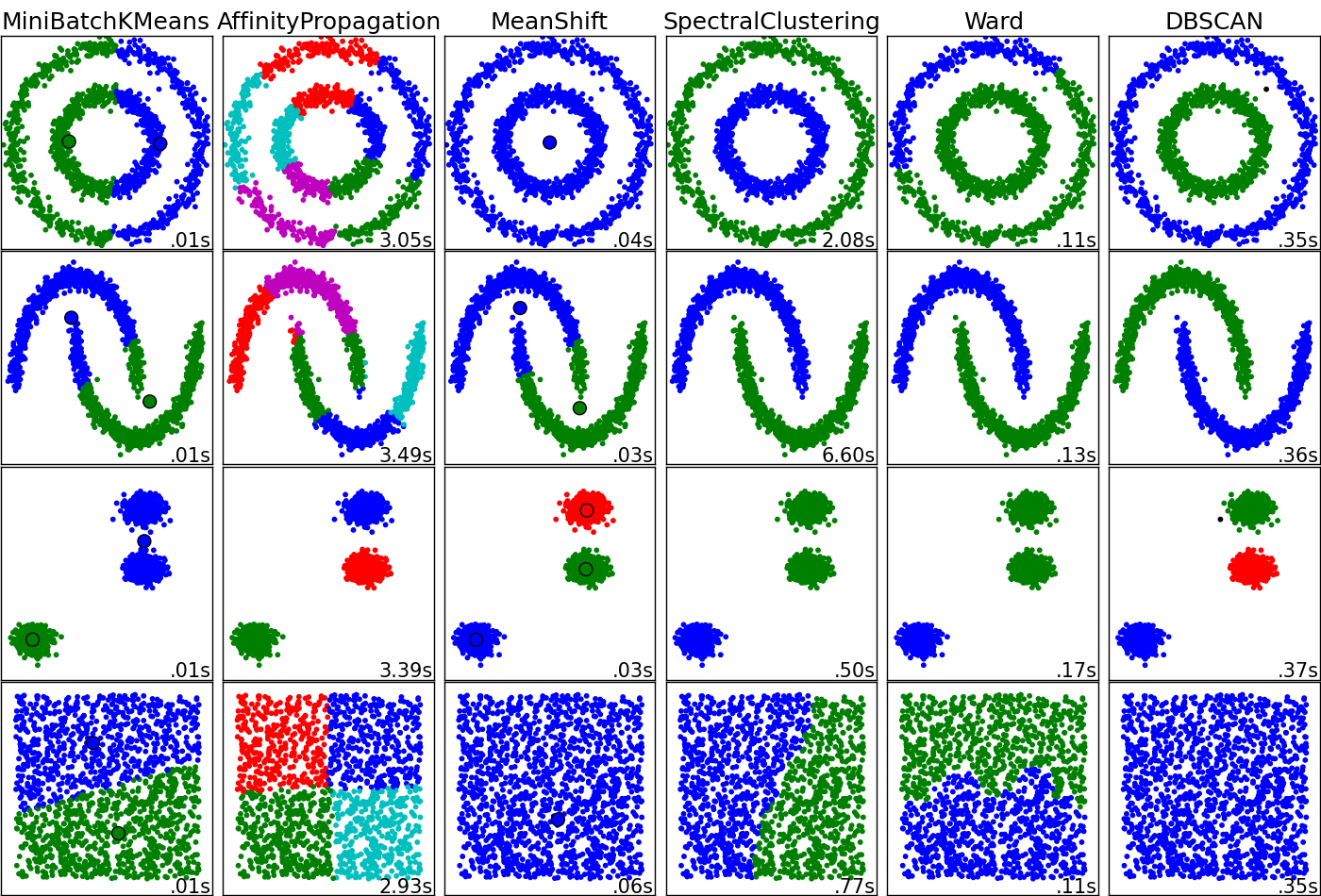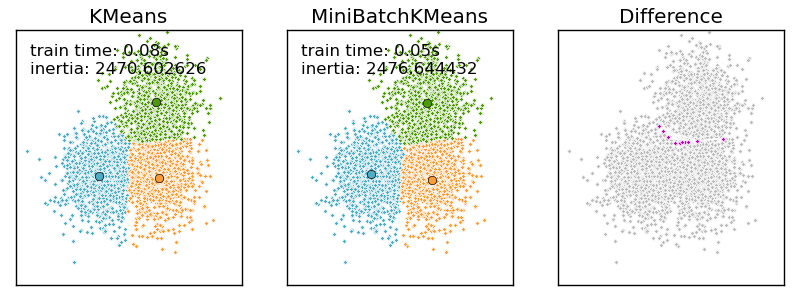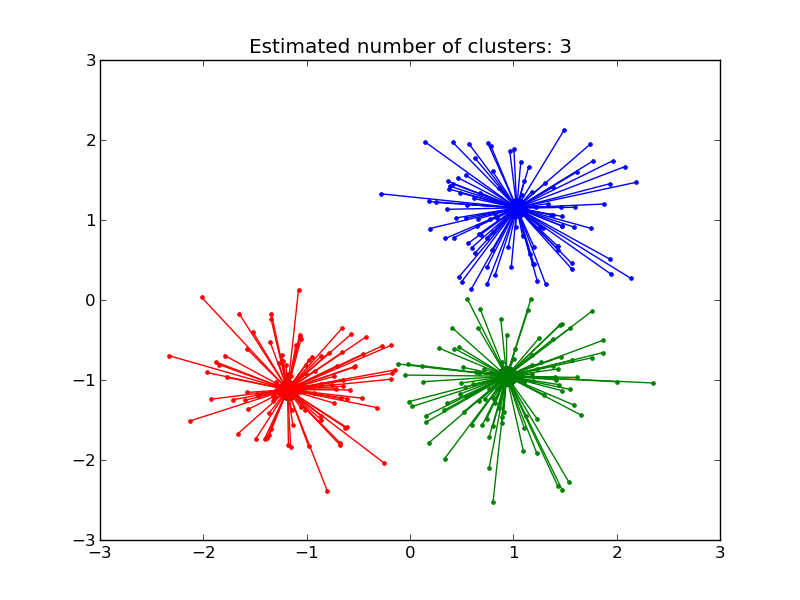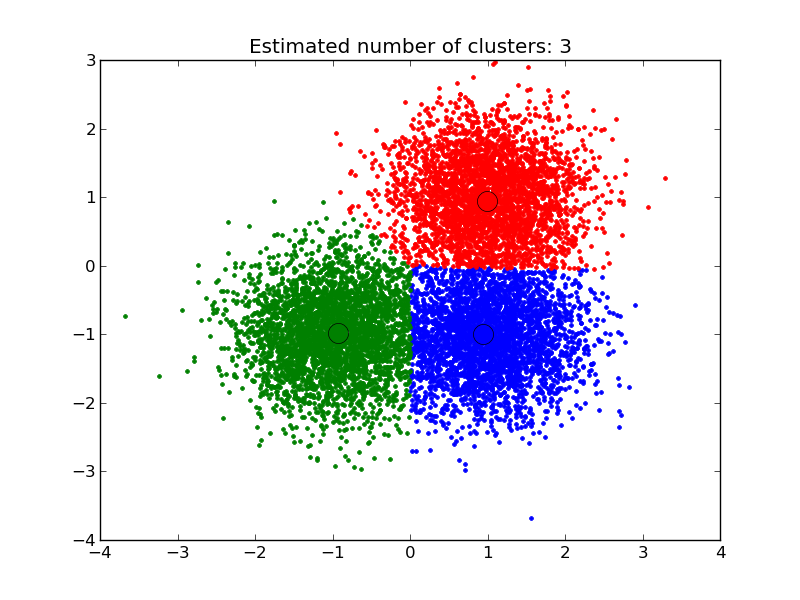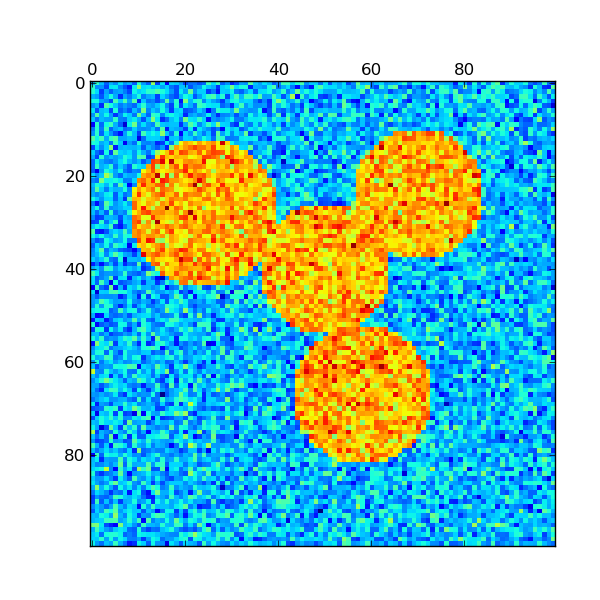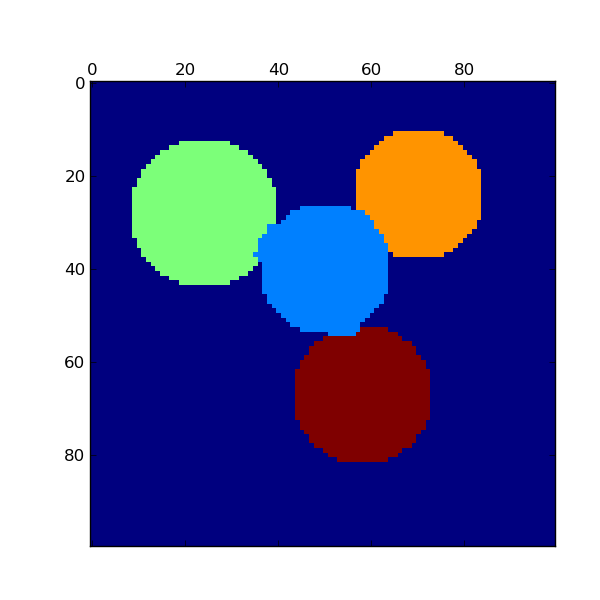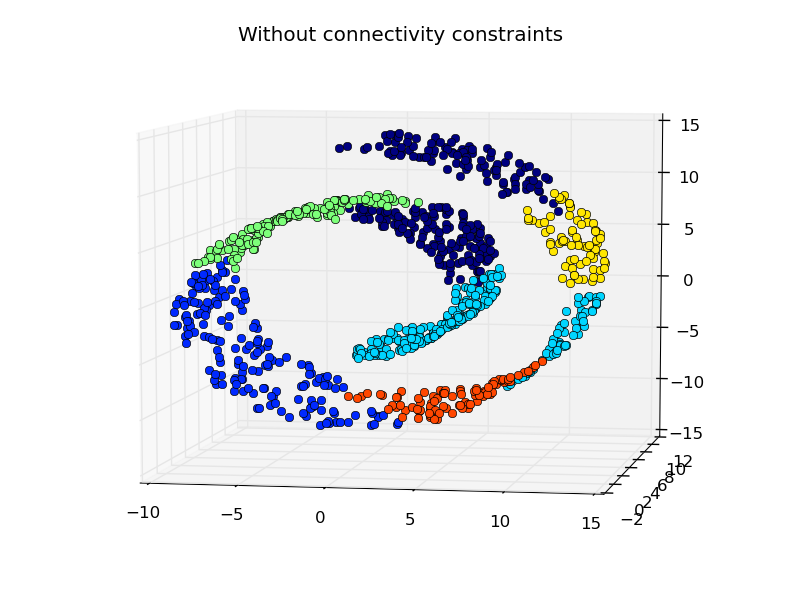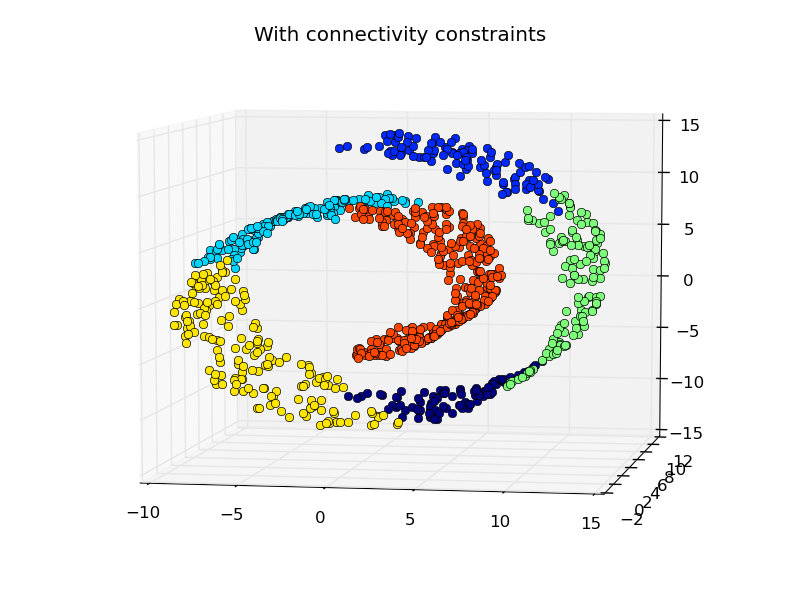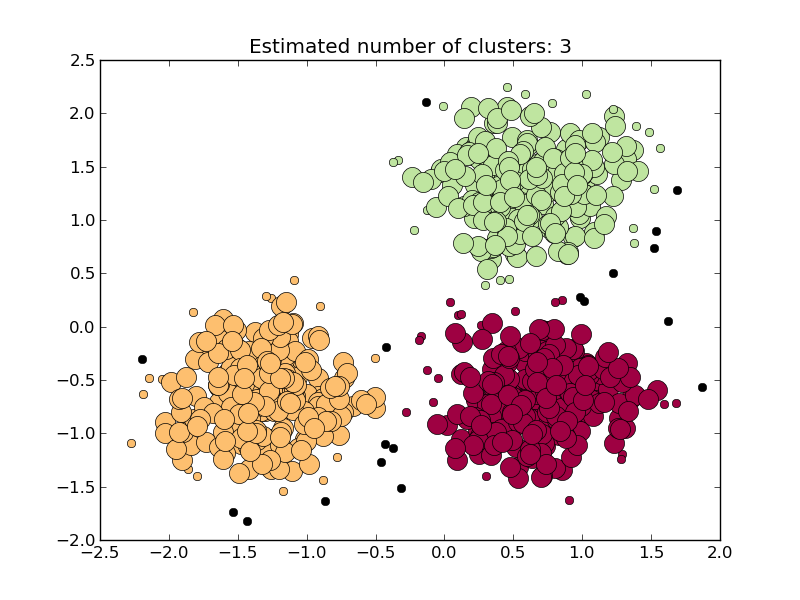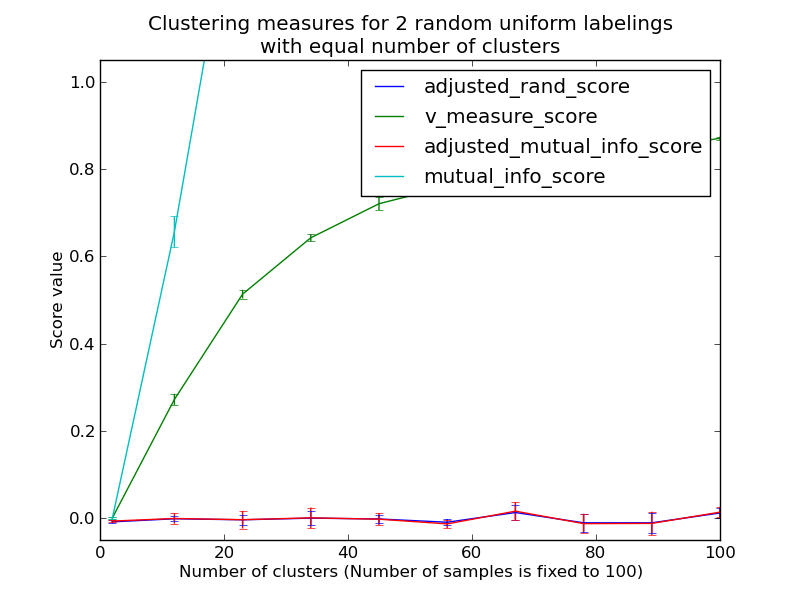2.3. Clustering¶
Clustering of unlabeled data can be performed with the module sklearn.cluster.
Each clustering algorithm comes in two variants: a class, that implements the fit method to learn the clusters on train data, and a function, that, given train data, returns an array of integer labels corresponding to the different clusters. For the class, the labels over the training data can be found in the labels_ attribute.
Input data
One important thing to note is that the algorithms implemented in this module take different kinds of matrix as input. On one hand, MeanShift and KMeans take data matrices of shape [n_samples, n_features]. These can be obtained from the classes in the sklearn.feature_extraction module. On the other hand, AffinityPropagation and SpectralClustering take similarity matrices of shape [n_samples, n_samples]. These can be obtained from the functions in the sklearn.metrics.pairwise module. In other words, MeanShift and KMeans work with points in a vector space, whereas AffinityPropagation and SpectralClustering can work with arbitrary objects, as long as a similarity measure exists for such objects.
2.3.1. Overview of clustering methods¶
| Method name | Parameters | Scalability | Usecase | Geometry (metric used) |
|---|---|---|---|---|
| K-Means | number of clusters | Very large n_samples, medium n_clusters with MiniBatch code | General-purpose, even cluster size, flat geometry, not too many clusters | Distances between points |
| Affinity propagation | damping, sample preference | Not scalable with n_samples | Many clusters, uneven cluster size, non-flat geometry | Graph distance (e.g. nearest-neighbor graph) |
| Mean-shift | bandwidth | Not scalable with n_samples | Many clusters, uneven cluster size, non-flat geometry | Distances between points |
| Spectral clustering | number of clusters | Medium n_samples, small n_clusters | Few clusters, even cluster size, non-flat geometry | Graph distance (e.g. nearest-neighbor graph) |
| Hierarchical clustering | number of clusters | Large n_samples and n_clusters | Many clusters, possibly connectivity constraints | Distances between points |
| DBSCAN | neighborhood size | Very large n_samples, medium n_clusters | Non-flat geometry, uneven cluster sizes | Distances between nearest points |
| Gaussian mixtures | many | Not scalable | Flat geometry, good for density estimation | Mahalanobis distances to centers |
Non-flat geometry clustering is useful when the clusters have a specific shape, i.e. a non-flat manifold, and the standard euclidean distance is not the right metric. This case arises in the two top rows of the figure above.
Gaussian mixture models, useful for clustering, are described in another chapter of the documentation dedicated to mixture models. KMeans can be seen as a special case of Gaussian mixture model with equal covariance per component.
2.3.2. K-means¶
The KMeans algorithm clusters data by trying to separate samples
in n groups of equal variance, minimizing a criterion known as the
‘inertia’ of the groups. This algorithm requires the number of clusters to
be specified. It scales well to large number of samples and has been used
across a large range of application areas in many different fields. It is
also equivalent to the expectation-maximization algorithm when setting the
covariance matrix to be diagonal, equal and small. The K-means algorithm
aims to choose centroids  that minimise the within cluster sum of
squares objective function with a dataset
that minimise the within cluster sum of
squares objective function with a dataset  with
with  samples:
samples:

K-means is often referred to as Lloyd’s algorithm. In basic terms, the
algorithm has three steps. The first step chooses the initial centroids, with
the most basic method being to choose  samples from the dataset
samples from the dataset
 . After initialization, K-means consists of looping between the
two other steps. The first step assigns each sample to its nearest centroid.
The second step creates new centroids by taking the mean value of all of the
samples assigned to each previous centroid. The difference between the old
and the new centroids are computed and the algorithm repeats these last two
steps until this value is less than a threshold. In other words, it repeats
until the centroids do not move significantly.
. After initialization, K-means consists of looping between the
two other steps. The first step assigns each sample to its nearest centroid.
The second step creates new centroids by taking the mean value of all of the
samples assigned to each previous centroid. The difference between the old
and the new centroids are computed and the algorithm repeats these last two
steps until this value is less than a threshold. In other words, it repeats
until the centroids do not move significantly.
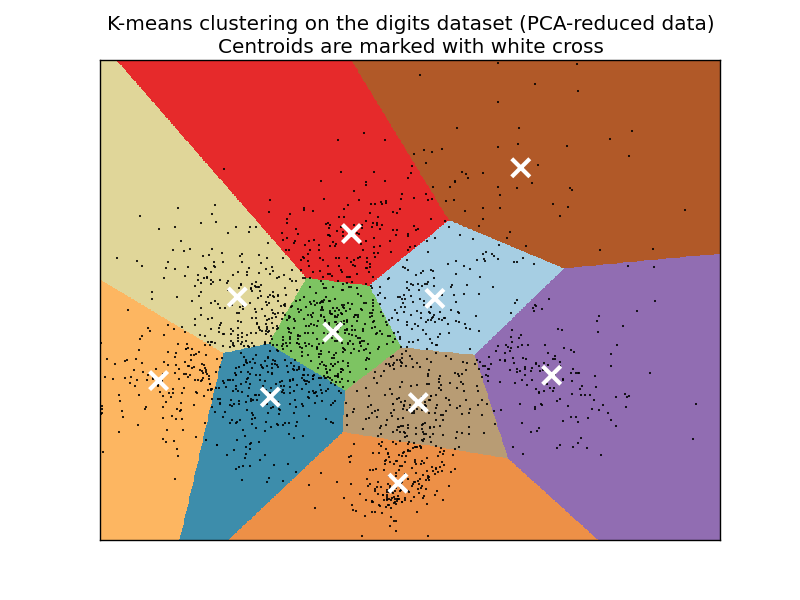
The algorithm can be understood through the concept of Voronoi diagrams. First the Voronoi diagram of the points is calculated using the current centroids. Each segment in the Voronoi diagram becomes a separate cluster. Secondly, the centroids are updated to the mean of each segment. The algorithm then repeats this until a stopping criterion is fulfilled. Usually, the algorithm stops when the relative decrease in the objective function between iterations is less than the given tolerance value. This is not the case in this implementation: iteration stops when centroids move less than the tolerance.
Given enough time, K-means will always converge, however this may be to a local minimum. This is highly dependent on the the initialization of the centroids. As a result, the computation is often done several times, with different initializations of the centroids. One method to help address this issue is the k-means++ initialization scheme, which has been implemented in scikit-learn (use the init='kmeans++' parameter). This initializes the centroids to be (generally) distant from each other, leading to provably better results than random initialization.
A parameter can be given to allow K-means to be run in parallel, called n_jobs. Giving this parameter a positive value uses that many processors (default: 1). A value of -1 uses all available processors, with -2 using one less, and so on. Parallelization generally speeds up computation at the cost of memory (in this case, multiple copies of centroids need to be stored, one for each job).
Warning
The parallel version of K-Means is broken on OS X when numpy uses the Accelerate Framework. This is expected behavior: Accelerate can be called after a fork but you need to execv the subprocess with the Python binary (which multiprocessing does not do under posix).
K-means can be used for vector quantization. This is achieved using the transform method of a trained model of KMeans.
Examples:
- A demo of K-Means clustering on the handwritten digits data: Clustering handwritten digits
2.3.2.1. Mini Batch K-Means¶
The MiniBatchKMeans is a variant of the KMeans algorithm which uses mini-batches to reduce the computation time, while still attempting to optimise the same objective function. Mini-batches are subsets of the input data, randomly sampled in each training iteration. These mini-batches drastically reduce the amount of computation required to converge to a local solution. In contrast to other algorithms that reduce the convergence time of k-means, mini-batch k-means produces results that are generally only slightly worse than the standard algorithm.
The algorithm iterates between two major steps, similar to vanilla k-means. In the first step, b samples are drawn randomly from the dataset, to form a mini-batch. These are then assigned to the nearest centroid. In the second step, the centroids are updated. In contrast to k-means, this is done on a per-sample basis. For each sample in the mini-batch, the assigned centroid is updated by taking the streaming average of the sample and all previous samples assigned to that centroid. This has the effect of decreasing the rate of change for a centroid over time. These steps are performed until convergence or a predetermined number of iterations is reached.
MiniBatchKMeans converges faster than KMeans, but the quality of the results is reduced. In practice this difference in quality can be quite small, as shown in the example and cited reference.
Examples:
- Comparison of the K-Means and MiniBatchKMeans clustering algorithms: Comparison of KMeans and MiniBatchKMeans
- Clustering text documents using k-means: Document clustering using sparse MiniBatchKMeans
- Online learning of a dictionary of parts of faces
References:
- “Web Scale K-Means clustering” D. Sculley, Proceedings of the 19th international conference on World wide web (2010)
2.3.3. Affinity Propagation¶
AffinityPropagation creates clusters by sending messages between pairs of samples until convergence. A dataset is then described using a small number of exemplars, which are identified as those most representative of other samples. The messages sent between pairs represent the suitability for one sample to be the exemplar of the other, which is updated in response to the values from other pairs. This updating happens iteratively until convergence, at which point the final exemplars are chosen, and hence the final clustering is given.
Affinity Propagation can be interesting as it chooses the number of clusters based on the data provided. For this purpose, the two important parameters are the preference, which controls how many exemplars are used, and the damping factor.
The main drawback of Affinity Propagation is its complexity. The
algorithm has a time complexity of the order  , where N
is the number of samples and T is the number of iterations until
convergence. Further, the memory complexity is of the order
, where N
is the number of samples and T is the number of iterations until
convergence. Further, the memory complexity is of the order
 if a dense similarity matrix is used, but reducible if a
sparse similarity matrix is used. This makes Affinity Propagation most
appropriate for small to medium sized datasets.
if a dense similarity matrix is used, but reducible if a
sparse similarity matrix is used. This makes Affinity Propagation most
appropriate for small to medium sized datasets.
Examples:
- Demo of affinity propagation clustering algorithm: Affinity Propagation on a synthetic 2D datasets with 3 classes.
- Visualizing the stock market structure Affinity Propagation on Financial time series to find groups of companies
Algorithm description: The messages sent between points belong to one of two categories. The first is the responsibility r(i, k), which is the accumulated evidence that sample k should be the exemplar for sample i. The second is the availability a(i, k) which is the accumulated evidence that sample i should choose sample k to be its exemplar, and considers the values for all other samples that k should be an exemplar. In this way, exemplars are chosen by samples if they are (1) similar enough to many samples and (2) chosen by many samples to be representative of themselves.
More formally, the responsibility of a sample k to be the exemplar of sample i is given by:
![r(i, k) \leftarrow s(i, k) - max [ a(i, \acute{k}) + s(i, \acute{k}) \forall \acute{k} \neq k ]](../_images/math/d77efeee658e6be46c5c46be29a4bbd581a033e8.png)
Where  is the similarity between samples i and k. The
availability of sample k to be the exemplar of sample i is given by:
is the similarity between samples i and k. The
availability of sample k to be the exemplar of sample i is given by:
![a(i, k) \leftarrow min [0, r(k, k) + \sum_{\acute{i}~s.t.~\acute{i} \notin \{i, k\}}{r(\acute{i}, k)}]](../_images/math/4a05b5c9581a59fb3ed76ddde6f4275e40465c46.png)
To begin with, all values for r and a are set to zero, and the calculation of each iterates until convergence.
2.3.4. Mean Shift¶
MeanShift clusters data by estimating blobs in a smooth density of points matrix. This algorithm automatically sets its numbers of cluster. It will have difficulties scaling to thousands of samples. The utility function estimate_bandwidth can be used to guess the optimal bandwidth for MeanShift from the data.
Examples:
- A demo of the mean-shift clustering algorithm: Mean Shift clustering on a synthetic 2D datasets with 3 classes.
2.3.5. Spectral clustering¶
SpectralClustering does a low-dimension embedding of the affinity matrix between samples, followed by a KMeans in the low dimensional space. It is especially efficient if the affinity matrix is sparse and the pyamg module is installed. SpectralClustering requires the number of clusters to be specified. It works well for a small number of clusters but is not advised when using many clusters.
For two clusters, it solves a convex relaxation of the normalised cuts problem on the similarity graph: cutting the graph in two so that the weight of the edges cut is small compared to the weights in of edges inside each cluster. This criteria is especially interesting when working on images: graph vertices are pixels, and edges of the similarity graph are a function of the gradient of the image.
Warning
Transforming distance to well-behaved similarities
Note that if the values of your similarity matrix are not well distributed, e.g. with negative values or with a distance matrix rather than a similarity, the spectral problem will be singular and the problem not solvable. In which case it is advised to apply a transformation to the entries of the matrix. For instance, in the case of a signed distance matrix, is common to apply a heat kernel:
similarity = np.exp(-beta * distance / distance.std())
See the examples for such an application.
Examples:
- Spectral clustering for image segmentation: Segmenting objects from a noisy background using spectral clustering.
- Segmenting the picture of Lena in regions: Spectral clustering to split the image of lena in regions.
2.3.5.1. Different label assignment strategies¶
Different label assignment strategies can be used, corresponding to the assign_labels parameter of SpectralClustering. The kmeans strategy can match finer details of the data, but it can be more unstable. In particular, unless you control the random_state, it may not be reproducible from run-to-run, as it depends on a random initialization. On the other hand, the discretize strategy is 100% reproducible, but it tends to create parcels of fairly even and geometrical shape.
| assign_labels=”kmeans” | assign_labels=”discretize” |
|---|---|
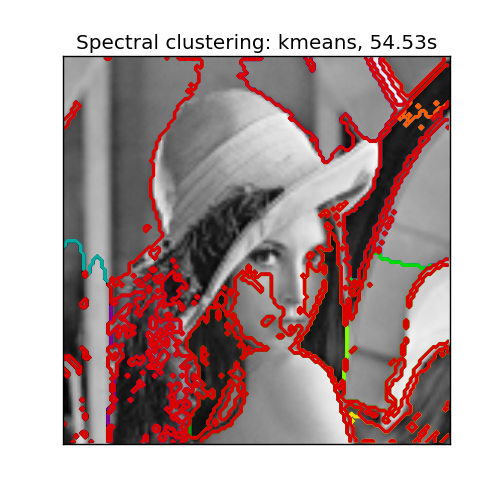 |
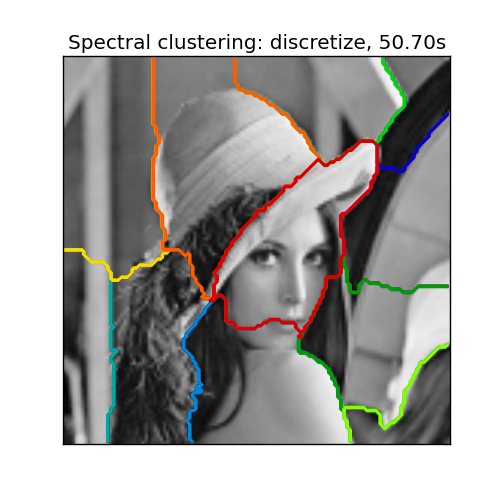 |
References:
- “A Tutorial on Spectral Clustering” Ulrike von Luxburg, 2007
- “Normalized cuts and image segmentation” Jianbo Shi, Jitendra Malik, 2000
- “A Random Walks View of Spectral Segmentation” Marina Meila, Jianbo Shi, 2001
- “On Spectral Clustering: Analysis and an algorithm” Andrew Y. Ng, Michael I. Jordan, Yair Weiss, 2001
2.3.6. Hierarchical clustering¶
Hierarchical clustering is a general family of clustering algorithms that build nested clusters by merging them successively. This hierarchy of clusters represented as a tree (or dendrogram). The root of the tree is the unique cluster that gathers all the samples, the leaves being the clusters with only one sample. See the Wikipedia page for more details.
The Ward object performs a hierarchical clustering based on the Ward algorithm, that is a variance-minimizing approach. At each step, it minimizes the sum of squared differences within all clusters (inertia criterion).
This algorithm can scale to large number of samples when it is used jointly with an connectivity matrix, but can be computationally expensive when no connectivity constraints are added between samples: it considers at each step all the possible merges.
2.3.6.1. Adding connectivity constraints¶
An interesting aspect of the Ward object is that connectivity constraints can be added to this algorithm (only adjacent clusters can be merged together), through an connectivity matrix that defines for each sample the neighboring samples following a given structure of the data. For instance, in the swiss-roll example below, the connectivity constraints forbid the merging of points that are not adjacent on the swiss roll, and thus avoid forming clusters that extend across overlapping folds of the roll.
The connectivity constraints are imposed via an connectivity matrix: a scipy sparse matrix that has elements only at the intersection of a row and a column with indices of the dataset that should be connected. This matrix can be constructed from a-priori information, for instance if you wish to cluster web pages, but only merging pages with a link pointing from one to another. It can also be learned from the data, for instance using sklearn.neighbors.kneighbors_graph to restrict merging to nearest neighbors as in the swiss roll example, or using sklearn.feature_extraction.image.grid_to_graph to enable only merging of neighboring pixels on an image, as in the Lena example.
Examples:
- A demo of structured Ward hierarchical clustering on Lena image: Ward clustering to split the image of lena in regions.
- Hierarchical clustering: structured vs unstructured ward: Example of Ward algorithm on a swiss-roll, comparison of structured approaches versus unstructured approaches.
- Feature agglomeration vs. univariate selection: Example of dimensionality reduction with feature agglomeration based on Ward hierarchical clustering.
2.3.7. DBSCAN¶
The DBSCAN algorithm views clusters as areas of high density separated by areas of low density. Due to this rather generic view, clusters found by DBSCAN can be any shape, as opposed to k-means which assumes that clusters are convex shaped. The central component to the DBSCAN is the concept of core samples, which are samples that are in areas of high density. A cluster is therefore a set of core samples, each close to each other (measured by some distance measure) and a set of non-core samples that are close to a core sample (but are not themselves core samples). There are two parameters to the algorithm, min_samples and eps, which define formally what we mean when we say dense. A higher min_samples or lower eps indicate higher density necessary to form a cluster.
More formally, we define a core sample as being a sample in the dataset such that there exist min_samples other samples within a distance of eps, which are defined as neighbors of the core sample. This tells us that the core sample is in a dense area of the vector space. A cluster is a set of core samples, that can be built by recursively by taking a core sample, finding all of its neighbors that are core samples, finding all of their neighbors that are core samples, and so on. A cluster also has a set of non-core samples, which are samples that are neighbors of a core sample in the cluster but are not themselves core samples. Intuitively, these samples are on the fringes of a cluster.
Any core sample is part of a cluster, by definition. Further, any cluster has at least min_samples points in it, following the definition of a core sample. For any sample that is not a core sample, and does have a distance higher than eps to any core sample, it is considered an outlier by the algorithm.
In the figure below, the color indicates cluster membership, with large circles indicating core samples found by the algorithm. Smaller circles are non-core samples that are still part of a cluster. Moreover, the outliers are indicated by black points below.
Examples:
Implementation
The algorithm is non-deterministic, however the core samples themselves will always belong to the same clusters (although the labels themselves may be different). The non-determinism comes from deciding on which cluster a non-core sample belongs to. A non-core sample can have a distance lower than eps to two core samples in different classes. Following from the triangular inequality, those two core samples would be more distant than eps from each other – else they would be in the same class. The non-core sample is simply assigned to which ever cluster is generated first, where the order is determined randomly within the code. Other than the ordering of, the dataset, the algorithm is deterministic, making the results relatively stable between iterations on the same data.
The current implementation relies heavily on NearestNeighbors to determine the number of samples within distance eps. This is to take advantage of the ball tree and kd-tree methods of speeding up neighbor searching and to avoid calculating the full distance matrix. We also retain the flexibility of custom metrics – for details, see NearestNeighbors.
References:
- “A Density-Based Algorithm for Discovering Clusters in Large Spatial Databases with Noise” Ester, M., H. P. Kriegel, J. Sander, and X. Xu, In Proceedings of the 2nd International Conference on Knowledge Discovery and Data Mining, Portland, OR, AAAI Press, pp. 226–231. 1996
2.3.8. Clustering performance evaluation¶
Evaluating the performance of a clustering algorithm is not as trivial as counting the number of errors or the precision and recall of a supervised classification algorithm. In particular any evaluation metric should not take the absolute values of the cluster labels into account but rather if this clustering define separations of the data similar to some ground truth set of classes or satisfying some assumption such that members belong to the same class are more similar that members of different classes according to some similarity metric.
2.3.8.1. Inertia¶
2.3.8.1.1. Presentation and usage¶
TODO: factorize inertia computation out of kmeans and then write me!
2.3.8.1.2. Advantages¶
- No need for the ground truth knowledge of the “real” classes.
2.3.8.1.3. Drawbacks¶
- Inertia makes the assumption that clusters are convex and isotropic which is not always the case especially of the clusters are manifolds with weird shapes: for instance inertia is a useless metrics to evaluate clustering algorithm that tries to identify nested circles on a 2D plane.
- Inertia is not a normalized metrics: we just know that lower values are better and bounded by zero. One potential solution would be to adjust inertia for random clustering (assuming the number of ground truth classes is known).
2.3.8.2. Adjusted Rand index¶
2.3.8.2.1. Presentation and usage¶
Given the knowledge of the ground truth class assignments labels_true and our clustering algorithm assignments of the same samples labels_pred, the adjusted Rand index is a function that measures the similarity of the two assignments, ignoring permutations and with chance normalization:
>>> from sklearn import metrics
>>> labels_true = [0, 0, 0, 1, 1, 1]
>>> labels_pred = [0, 0, 1, 1, 2, 2]
>>> metrics.adjusted_rand_score(labels_true, labels_pred)
0.24...
One can permute 0 and 1 in the predicted labels and rename 2 by 3 and get the same score:
>>> labels_pred = [1, 1, 0, 0, 3, 3]
>>> metrics.adjusted_rand_score(labels_true, labels_pred)
0.24...
Furthermore, adjusted_rand_score is symmetric: swapping the argument does not change the score. It can thus be used as a consensus measure:
>>> metrics.adjusted_rand_score(labels_pred, labels_true)
0.24...
Perfect labeling is scored 1.0:
>>> labels_pred = labels_true[:]
>>> metrics.adjusted_rand_score(labels_true, labels_pred)
1.0
Bad (e.g. independent labelings) have negative or close to 0.0 scores:
>>> labels_true = [0, 1, 2, 0, 3, 4, 5, 1]
>>> labels_pred = [1, 1, 0, 0, 2, 2, 2, 2]
>>> metrics.adjusted_rand_score(labels_true, labels_pred)
-0.12...
2.3.8.2.2. Advantages¶
- Random (uniform) label assignments have a ARI score close to 0.0 for any value of n_clusters and n_samples (which is not the case for raw Rand index or the V-measure for instance).
- Bounded range [-1, 1]: negative values are bad (independent labelings), similar clusterings have a positive ARI, 1.0 is the perfect match score.
- No assumption is made on the cluster structure: can be used to compare clustering algorithms such as k-means which assumes isotropic blob shapes with results of spectral clustering algorithms which can find cluster with “folded” shapes.
2.3.8.2.3. Drawbacks¶
Contrary to inertia, ARI requires knowledge of the ground truth classes while is almost never available in practice or requires manual assignment by human annotators (as in the supervised learning setting).
However ARI can also be useful in a purely unsupervised setting as a building block for a Consensus Index that can be used for clustering model selection (TODO).
Examples:
- Adjustment for chance in clustering performance evaluation: Analysis of the impact of the dataset size on the value of clustering measures for random assignments.
2.3.8.2.4. Mathematical formulation¶
If C is a ground truth class assignment and K the clustering, let us
define  and
and  as:
as:
 , the number of pairs of elements that are in the same set
in C and in the same set in K
, the number of pairs of elements that are in the same set
in C and in the same set in K , the number of pairs of elements that are in different sets
in C and in different sets in K
, the number of pairs of elements that are in different sets
in C and in different sets in K
The raw (unadjusted) Rand index is then given by:

Where  is the total number of possible pairs
in the dataset (without ordering).
is the total number of possible pairs
in the dataset (without ordering).
However the RI score does not guarantee that random label assignments will get a value close to zero (esp. if the number of clusters is in the same order of magnitude as the number of samples).
To counter this effect we can discount the expected RI ![E[\text{RI}]](../_images/math/62634a547d50da7d34b580324a5d552a22385287.png) of
random labelings by defining the adjusted Rand index as follows:
of
random labelings by defining the adjusted Rand index as follows:
![\text{ARI} = \frac{\text{RI} - E[\text{RI}]}{\max(\text{RI}) - E[\text{RI}]}](../_images/math/cea8da7bd0f8861d7099f3ecdb9992f1a065a729.png)
References
- Comparing Partitions L. Hubert and P. Arabie, Journal of Classification 1985
- Wikipedia entry for the adjusted Rand index
2.3.8.3. Mutual Information based scores¶
2.3.8.3.1. Presentation and usage¶
Given the knowledge of the ground truth class assignments labels_true and our clustering algorithm assignments of the same samples labels_pred, the Mutual Information is a function that measures the agreement of the two assignments, ignoring permutations. Two different normalized versions of this measure are available, Normalized Mutual Information(NMI) and Adjusted Mutual Information(AMI). NMI is often used in the literature while AMI was proposed more recently and is normalized against chance:
>>> from sklearn import metrics
>>> labels_true = [0, 0, 0, 1, 1, 1]
>>> labels_pred = [0, 0, 1, 1, 2, 2]
>>> metrics.adjusted_mutual_info_score(labels_true, labels_pred)
0.22504...
One can permute 0 and 1 in the predicted labels and rename 2 by 3 and get the same score:
>>> labels_pred = [1, 1, 0, 0, 3, 3]
>>> metrics.adjusted_mutual_info_score(labels_true, labels_pred)
0.22504...
All, mutual_info_score, adjusted_mutual_info_score and normalized_mutual_info_score are symmetric: swapping the argument does not change the score. Thus they can be used as a consensus measure:
>>> metrics.adjusted_mutual_info_score(labels_pred, labels_true)
0.22504...
Perfect labeling is scored 1.0:
>>> labels_pred = labels_true[:]
>>> metrics.adjusted_mutual_info_score(labels_true, labels_pred)
1.0
>>> metrics.normalized_mutual_info_score(labels_true, labels_pred)
1.0
This is not true for mutual_info_score, which is therefore harder to judge:
>>> metrics.mutual_info_score(labels_true, labels_pred)
0.69...
Bad (e.g. independent labelings) have non-positive scores:
>>> labels_true = [0, 1, 2, 0, 3, 4, 5, 1]
>>> labels_pred = [1, 1, 0, 0, 2, 2, 2, 2]
>>> metrics.adjusted_mutual_info_score(labels_true, labels_pred)
-0.10526...
2.3.8.3.2. Advantages¶
- Random (uniform) label assignments have a AMI score close to 0.0 for any value of n_clusters and n_samples (which is not the case for raw Mutual Information or the V-measure for instance).
- Bounded range [0, 1]: Values close to zero indicate two label assignments that are largely independent, while values close to one indicate significant agreement. Further, values of exactly 0 indicate purely independent label assignments and a AMI of exactly 1 indicates that the two label assignments are equal (with or without permutation).
- No assumption is made on the cluster structure: can be used to compare clustering algorithms such as k-means which assumes isotropic blob shapes with results of spectral clustering algorithms which can find cluster with “folded” shapes.
2.3.8.3.3. Drawbacks¶
Contrary to inertia, MI-based measures require the knowledge of the ground truth classes while almost never available in practice or requires manual assignment by human annotators (as in the supervised learning setting).
However MI-based measures can also be useful in purely unsupervised setting as a building block for a Consensus Index that can be used for clustering model selection.
NMI and MI are not adjusted against chance.
Examples:
- Adjustment for chance in clustering performance evaluation: Analysis of the impact of the dataset size on the value of clustering measures for random assignments. This example also includes the Adjusted Rand Index.
2.3.8.3.4. Mathematical formulation¶
Assume two label assignments (of the same N objects),  and
and  .
Their entropy is the amount of uncertainty for a partition set, defined by:
.
Their entropy is the amount of uncertainty for a partition set, defined by:

where  is the probability that an object picked at
random from
is the probability that an object picked at
random from  falls into class
falls into class  . Likewise for
. Likewise for  :
:

With  . The mutual information (MI) between
. The mutual information (MI) between  and
and  is calculated by:
is calculated by:

where  is the probability that an object
picked at random falls into both classes
is the probability that an object
picked at random falls into both classes  and
and  .
.
The normalized mutual information is defined as

This value of the mutual information and also the normalized variant is not adjusted for chance and will tend to increase as the number of different labels (clusters) increases, regardless of the actual amount of “mutual information” between the label assignments.
The expected value for the mutual information can be calculated using the
following equation, from Vinh, Epps, and Bailey, (2009). In this equation,
 (the number of elements in
(the number of elements in  ) and
) and
 (the number of elements in
(the number of elements in  ).
).
![E[\text{MI}(U,V)]=\sum_{i=1}^|U| \sum_{j=1}^|V| \sum_{n_{ij}=(a_i+b_j-N)^+
}^{\min(a_i, b_j)} \frac{n_{ij}}{N}\log \left( \frac{ N.n_{ij}}{a_i b_j}\right)
\frac{a_i!b_j!(N-a_i)!(N-b_j)!}{N!n_{ij}!(a_i-n_{ij})!(b_j-n_{ij})!
(N-a_i-b_j+n_{ij})!}](../_images/math/a2b6760e3538878467adc1da0f03e28bd67c4a85.png)
Using the expected value, the adjusted mutual information can then be calculated using a similar form to that of the adjusted Rand index:
![\text{AMI} = \frac{\text{MI} - E[\text{MI}]}{\max(H(U), H(V)) - E[\text{MI}]}](../_images/math/04e7e8db618ff16863d1520c81bbd8e6620565d1.png)
References
- Strehl, Alexander, and Joydeep Ghosh (2002). “Cluster ensembles – a knowledge reuse framework for combining multiple partitions”. Journal of Machine Learning Research 3: 583–617. doi:10.1162/153244303321897735
- Vinh, Epps, and Bailey, (2009). “Information theoretic measures for clusterings comparison”. Proceedings of the 26th Annual International Conference on Machine Learning - ICML ‘09. doi:10.1145/1553374.1553511. ISBN 9781605585161.
- Vinh, Epps, and Bailey, (2010). Information Theoretic Measures for Clusterings Comparison: Variants, Properties, Normalization and Correction for Chance}, JMLR http://jmlr.csail.mit.edu/papers/volume11/vinh10a/vinh10a.pdf
- Wikipedia entry for the (normalized) Mutual Information
- Wikipedia entry for the Adjusted Mutual Information
2.3.8.4. Homogeneity, completeness and V-measure¶
2.3.8.4.1. Presentation and usage¶
Given the knowledge of the ground truth class assignments of the samples, it is possible to define some intuitive metric using conditional entropy analysis.
In particular Rosenberg and Hirschberg (2007) define the following two desirable objectives for any cluster assignment:
- homogeneity: each cluster contains only members of a single class.
- completeness: all members of a given class are assigned to the same cluster.
We can turn those concept as scores homogeneity_score and completeness_score. Both are bounded below by 0.0 and above by 1.0 (higher is better):
>>> from sklearn import metrics
>>> labels_true = [0, 0, 0, 1, 1, 1]
>>> labels_pred = [0, 0, 1, 1, 2, 2]
>>> metrics.homogeneity_score(labels_true, labels_pred)
0.66...
>>> metrics.completeness_score(labels_true, labels_pred)
0.42...
Their harmonic mean called V-measure is computed by v_measure_score:
>>> metrics.v_measure_score(labels_true, labels_pred)
0.51...
The V-measure is actually equivalent to the mutual information (NMI) discussed above normalized by the sum of the label entropies [B2011].
Homogeneity, completeness and V-measure can be computed at once using homogeneity_completeness_v_measure as follows:
>>> metrics.homogeneity_completeness_v_measure(labels_true, labels_pred)
...
(0.66..., 0.42..., 0.51...)
The following clustering assignment is slightly better, since it is homogeneous but not complete:
>>> labels_pred = [0, 0, 0, 1, 2, 2]
>>> metrics.homogeneity_completeness_v_measure(labels_true, labels_pred)
...
(1.0, 0.68..., 0.81...)
Note
v_measure_score is symmetric: it can be used to evaluate the agreement of two independent assignments on the same dataset.
This is not the case for completeness_score and homogeneity_score: both are bound by the relationship:
homogeneity_score(a, b) == completeness_score(b, a)
2.3.8.4.2. Advantages¶
- Bounded scores: 0.0 is as bad as it can be, 1.0 is a perfect score
- Intuitive interpretation: clustering with bad V-measure can be qualitatively analyzed in terms of homogeneity and completeness to better feel what ‘kind’ of mistakes is done by the assignment.
- No assumption is made on the cluster structure: can be used to compare clustering algorithms such as k-means which assumes isotropic blob shapes with results of spectral clustering algorithms which can find cluster with “folded” shapes.
2.3.8.4.3. Drawbacks¶
The previously introduced metrics are not normalized w.r.t. random labeling: this means that depending on the number of samples, clusters and ground truth classes, a completely random labeling will not always yield the same values for homogeneity, completeness and hence v-measure. In particular random labeling won’t yield zero scores especially when the number of clusters is large.
This problem can safely be ignored when the number of samples is more than a thousand and the number of clusters is less than 10. For smaller sample sizes or larger number of clusters it is safer to use an adjusted index such as the Adjusted Rand Index (ARI).
- These metrics require the knowledge of the ground truth classes while almost never available in practice or requires manual assignment by human annotators (as in the supervised learning setting).
Examples:
- Adjustment for chance in clustering performance evaluation: Analysis of the impact of the dataset size on the value of clustering measures for random assignments.
2.3.8.4.4. Mathematical formulation¶
Homogeneity and completeness scores are formally given by:


where  is the conditional entropy of the classes given
the cluster assignments and is given by:
is the conditional entropy of the classes given
the cluster assignments and is given by:

and  is the entropy of the classes and is given by:
is the entropy of the classes and is given by:

with  the total number of samples,
the total number of samples,  and
and  the number of samples respectively belonging to class
the number of samples respectively belonging to class  and
cluster
and
cluster  , and finally
, and finally  the number of samples
from class
the number of samples
from class  assigned to cluster
assigned to cluster  .
.
The conditional entropy of clusters given class  and the
entropy of clusters
and the
entropy of clusters  are defined in a symmetric manner.
are defined in a symmetric manner.
Rosenberg and Hirschberg further define V-measure as the harmonic mean of homogeneity and completeness:

References
| [RH2007] | V-Measure: A conditional entropy-based external cluster evaluation measure Andrew Rosenberg and Julia Hirschberg, 2007 |
| [B2011] | Identication and Characterization of Events in Social Media, Hila Becker, PhD Thesis. |
2.3.8.5. Silhouette Coefficient¶
2.3.8.5.1. Presentation and usage¶
If the ground truth labels are not known, evaluation must be performed using the model itself. The Silhouette Coefficient (sklearn.metrics.silhouette_score) is an example of such an evaluation, where a higher Silhouette Coefficient score relates to a model with better defined clusters. The Silhouette Coefficient is defined for each sample and is composed of two scores:
- a: The mean distance between a sample and all other points in the same class.
- b: The mean distance between a sample and all other points in the next nearest cluster.
The Silhoeutte Coefficient s for a single sample is then given as:

The Silhouette Coefficient for a set of samples is given as the mean of the Silhouette Coefficient for each sample.
>>> from sklearn import metrics
>>> from sklearn.metrics import pairwise_distances
>>> from sklearn import datasets
>>> dataset = datasets.load_iris()
>>> X = dataset.data
>>> y = dataset.target
In normal usage, the Silhouette Coefficient is applied to the results of a cluster analysis.
>>> import numpy as np
>>> from sklearn.cluster import KMeans
>>> kmeans_model = KMeans(n_clusters=3, random_state=1).fit(X)
>>> labels = kmeans_model.labels_
>>> metrics.silhouette_score(X, labels, metric='euclidean')
...
0.55...
References
- Peter J. Rousseeuw (1987). “Silhouettes: a Graphical Aid to the Interpretation and Validation of Cluster Analysis”. Computational and Applied Mathematics 20: 53–65. doi:10.1016/0377-0427(87)90125-7.
2.3.8.5.2. Advantages¶
- The score is bounded between -1 for incorrect clustering and +1 for highly dense clustering. Scores around zero indicate overlapping clusters.
- The score is higher when clusters are dense and well separated, which relates to a standard concept of a cluster.
2.3.8.5.3. Drawbacks¶
- The Silhouette Coefficient is generally higher for convex clusters than other concepts of clusters, such as density based clusters like those obtained through DBSCAN.


